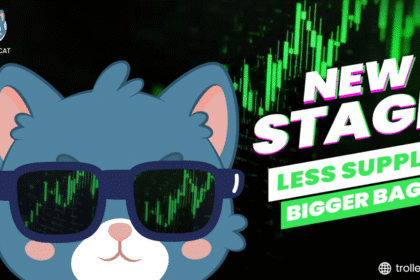According to the latest industry insights, the global crypto custody market is growing at an unprecedented rate and is expected to hit over $100B by 2033 from $41B in 2023. This is ‘driven by growing digital asset adoption, increasing institutional demand for custody solutions and tokenization.

As financial ‘institutions and custodians are scrambling to provide scalable, compliant digital asset storage solutions, Ripple’s “Digital Asset Custody: Quick Guide for Custodians” is a playbook for companies looking to enter or expand into this market.
But what’s behind this growth and how can institutions succeed?
Why is Crypto Custody Booming?
Institutional crypto adoption has changed the custody landscape, companies and asset managers are looking for custody solutions that do more than just safekeeping. Ripple’s report names three key drivers behind the $100B custody boom:
1. Institutional Demand for Crypto Custody
– Financial ‘institutions need regulated custody solutions to manage their digital asset portfolios.
– Traditional players like ‘BlackRock and Fidelity have already entered the crypto space, so there’s demand for institutional-grade custody services.
– Banks and hedge funds need ‘insurance-backed custody solutions that are compliant.
2. Tokenization
– Tokenized real-world assets (RWAs) ‘will make up more than 10% of global assets by 2030.
– Institutions need custody ‘solutions that can handle tokenized assets efficiently and securely.
– Interoperable custody solutions ‘supporting multiple blockchains will be required to support blockchain-based financial instruments.
3. Regulatory ‘Pressures and Compliance Requirements
– The custody ‘solution must be compliant with evolving global financial regulations.
– Management will need to establish governance controls, security frameworks and efficient transaction settlement systems.
– Companies not offering compliant solutions will be left behind in the race.

How Ripple’s Solutions are Different
Ripple has been offering institutional-grade custody for digital assets with full suite of security, liquidity and compliance features. The company’s Ripple Custody is available in 20 jurisdictions and offers:
- Modular Security Models: multi-signature authorization, biometrical access, and hardware security modules (HSMs).
- Built-in Governance Controls: allow companies to create their desired structure for their assets and to assign multiple layers of authentication and access.
- Blockchains Interoperability: support for most *multi-blockchain networks like Ethereum, Solana, Private Blockchain, etc.
Why Institutions Use Ripple Custody
Feature | Benefit for Institutions |
Regulatory Compliance | Meets global financial laws and custody regulations |
Scalable Infrastructure | Handles high transaction volumes efficiently |
Multi-Chain Support | Securely manages assets across multiple blockchains |
Enterprise-Grade Security | Protects against hacks and fraud with advanced security measures |
Industry Perspective: Ripple’s Report Analysis
We’ve seen digital asset custody go from a niche service to a mainstream financial necessity. Ripple’s latest insights validate what many industry experts have been saying—institutional investors are no longer hesitant about crypto but they demand top-tier custody solutions.
From tokenization to regulatory compliance, the industry is moving towards a more structured digital economy where asset management will be the differentiator. Those custodians who don’t adapt to these changes will be left behind as demand grows.
With its strong regulatory presence and blockchain expertise, Ripple is well-positioned to lead the charge in institutional crypto custody. With banks and asset managers looking for solutions, this may become one of the most profitable areas in the crypto industry in the next decade.
Challenges in the Crypto Custody Market
Despite fast institutional adoption, there are several factors that may hinder digital asset custody:
1. Security Risks and Cyber Threats
– Custodians must protect assets from hacks, phishing and insider threats.
– We’ve already seen high profile security breaches that question the need for more cybersecurity.
2. Unclear Global Regulations
– Crypto custody regulations vary by jurisdiction creating legal hurdles for companies operating globally.
– Lack of global standards slows down adoption for traditional financial institutions.
3. Technical Barriers and Integration Issues
– Many custodians can’t integrate with multiple blockchains and legacy financial systems.
– Firms need scalable solutions that support high transaction volume without network congestion.

What’s next for Crypto Custody?
Institutional crypto custody’s future is how custodians adjust to market needs. Ripple’s insight has identified three key trends for institutions:
✔ Rise of Institutional-Grade DeFi – Custodians will have to integrate DeFi solutions with Traditional Finance.
✔ More Tokenized Assets — Asset managers will be looking for custody services for tokenized stocks, bonds and commodities.
✔ Regulatory Standardization — Governments may propose global frameworks to ease crypto custody compliance.
The battle for institutional custody has just begun with $100 billion at stake.
Conclusion: Ripple’s Vision for Crypto Custody Leadership
Ripple’s report shows the rapid growth of the crypto custody market and digital assets are driving the demand. Most institutions need advanced security, compliance and blockchain integration. Tokenization is changing asset management; therefore, there is more demand for scalable custody solutions. Ripple Custody is well-positioned to be a leader with multi-chain support and clarity on regulatory compliance.
As the financial landscape evolves, custodians that will focus on security, scalability and compliance will lead the digital asset revolution.
The BIT Journal is available around the clock, providing you with updated information about the state of the crypto world. Follow us on Twitter and LinkedIn, and join our Telegram channel.
FAQ
1. Why is the crypto custody market growing so fast?
Increased demand due to institutional crypto adoption, tokenization and regulations for compliance.###
2. How does Ripple’s custody solution stack up?
Ripple Custody offers best-in-class, regulatory compliance blockchain interoperability enterprise-grade security.
3. What are the pain points for crypto custodians?
The custodian must be able to deal with the emerging security threats, regulatory hurdles and complexity of blockchain integrations tied to market needs.
4. How will Tokenization impact Crypto Custody?
By 2030, over 10% of the world’s assets will be tokenized and need asset management solutions custodians can offer.
5. How will regulations shape the future of crypto custody?
Global regulators may create a set of unified frameworks where each player ensures a compliant and risk-managed way of storing digital assets.
Glossary
- Crypto Custody: A service that secures and stores digital assets on behalf of institutional investors or individual investors.
- Tokenization: The process of converting real-world assets into blockchain-based tokens.
- Smart Contract Platform (SCP): A blockchain that supports decentralized applications and automated contracts.
- Liquidity Provider: A company that provides means for large volume trading by supplying liquidity to crypto markets.
- Regulatory Compliance: Conformity to the relevant financial laws and regulatory framework for virtual currencies.





























